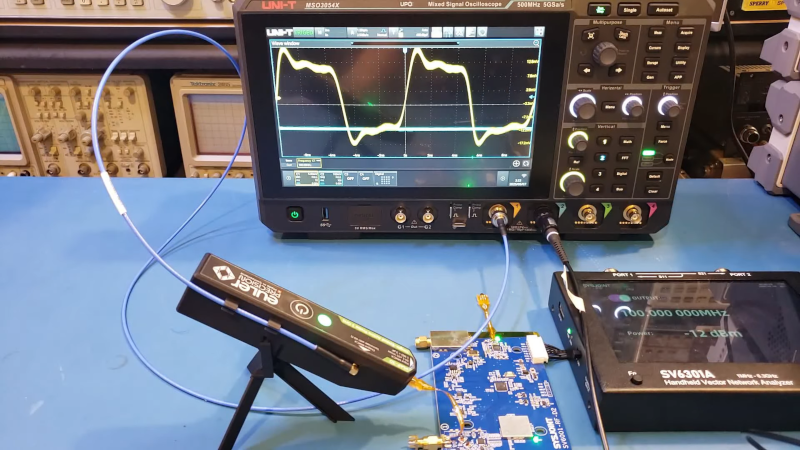When you think of a scope probe, you usually think of what is basically a wire with a spring hook and an attenuator. Those are passive probes. [Kerry Wong] shows off a pre-release active probe that sidesteps some problems with those ordinary passive probes.
The trick is that passive probes have input capacitance that interferes with very high-frequency signals. They also tend to have less noise. Although the probe isn’t on the market yet, it is set to debut at a price lower than competitive probes. Still, be warned. The reason you don’t see them more often is that $1,000 is relatively inexpensive for an active probe.
Because the probe is pretty hefty, it comes with a tripod that can hold it while you use it. [Kerry] connects some probe adapters to a PCB with two square wave oscillators. Square waves are a good test waveform because they have odd-numbered harmonics that rise well above the target frequency.
The probe adapters are a little longer than you might like, which causes some ringing on the input signal. However, if you compare the results to a standard passive probe, you’ll quickly see the value of the active probe setup.
You can save some money if you roll your own, of course. Most of the ones we’ve seen don’t quite make 3 GHz, though.
















I didn’t spend 20mins to watch the video, but what’s the use of a 3GHz probe on a 500MHz scope?
Perhaps you should watch the video then.
He probes a 57 MHz square-wave clock and shows non-trivial signal distortion due to higher harmonics seeing a different capacitance. It demonstrates that the harmonics are important even out to at least the low tens of the 57 MHz frequency.
To look at a 30 mhz waveform ideally you want a 250 mhz scope or better.
Otherwise, how can you see even order harmonic distortion?
Even order is multiples of the fundamental. IE, on a 30 mhz signal, you would need a 250 mhz scope to see 8th harmonic.
And to see the distortion it caused, you’d need a scope price that is flat to 250 mhz or better.
BUF802: https://www.ti.com/lit/ds/symlink/buf802.pdf
Anyone looking for a somewhat simpler option with 1 GHz BW (and 8000 V/µs slew rate on-par with BUF802) might be interested in putting BUF602 (SOT23) and an u.fl connector on a little flex PCB, offloading just a quiet, isolated power supply.
And if the circuit to be measured can tolerate resistive load, a low inductance series resistor to 50 ohm coax cable works well even at 1 GHz, and is easy and cheap to build.